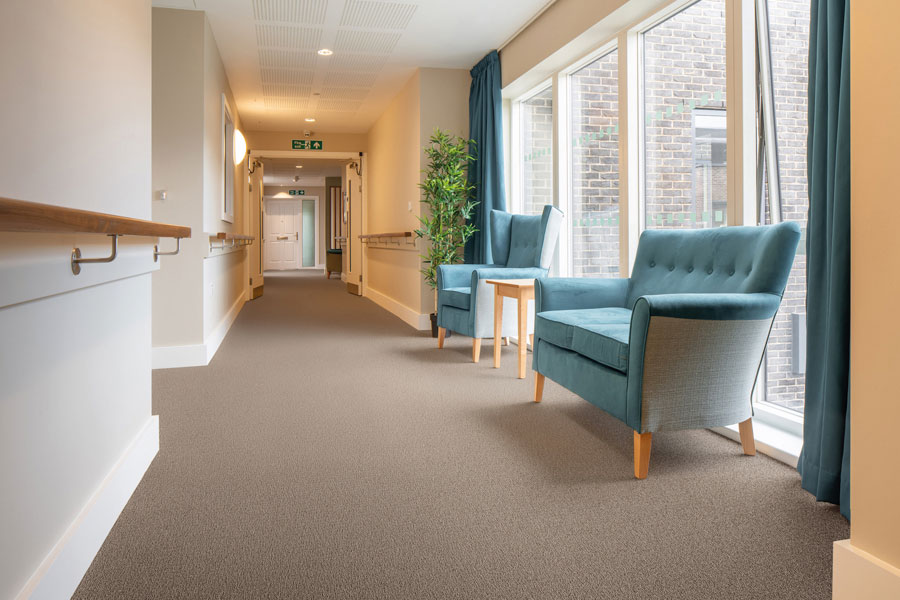GRADUS has launched an interactive Dementia Design Tool that enables designers and specifiers to create inclusive designs for their buildings so people with dementia can use them independently and comfortably.
Created in association with the Dementia Services Development Centre at the University of Stirling, the digital tool is part of Gradus’s new ‘See Through Their Eyes’ campaign to raise industry awareness of the importance of dementia-inclusive design in care homes and other healthcare facilities.
Steve Watt, managing director at Gradus, comments: ‘There are currently 12 million people in the UK aged 65 or over, and by 2030, it’s anticipated that above 21% of the population will be over 65. This means the issue of disability-free life expectancy and how to keep increasing it is a huge one that’s only going to grow in the coming years.
‘As leaders in contract interior solutions, we’re encouraging the whole industry to take this issue seriously and start to plan for independent living today, tomorrow and in the future. That’s what the ‘See Through Their Eyes’ campaign and our new Dementia Design Tool are all about.’
Dementia designs – on demand
Available to use in consultation with Gradus’s team of specialists, the Gradus Dementia Design Tool guides designers, and specifiers through every step of the design process – ensuring dementia-inclusivity is automatically built into the projects they work on.
For every room in the building, users can choose from a range of Gradus and Gerflor solutions, all of which have been certified by the Dementia Services Development Centre at the University of Stirling.
This is in recognition of how they help reduce trips, slips, and falls, offer support and guidance, and negate sight loss by aiding navigation around a building.
The products in the tool include Gradus’s Carezone carpet – rated ‘1a’ by the centre in recognition of its suitability for dementia environments – as well as the company’s ranges of barrier matting, wall protection, and contract flooring accessories, and also Gerflor products such as Taralay Impression Control safety flooring.
Crucially, the tool reportedly provides users with guidance on tonal contrast, one of the critical aspects of dementia design. For example, it’s vital people with dementia can see where the floor ends and the wall begins, meaning there should be at least 30 points of light reflectance value (LRV) between these two surfaces.
Accordingly, the Gradus Dementia Design Tool warns users with red crosses when two surfaces are failing to provide the correct contrast and reassures them with green ticks when the contrast is acceptable.
Steve Watt adds: ‘Designing for people with dementia isn’t easy, and that’s why we’re launching our new Dementia Design Tool, which provides users with the benefits of our decades of experience in an easy-to-use app.
‘This allows designers and specifiers to create dementia-inclusive environments quickly and easily, without the lengthy deliberations that are required when doing it in a manual way.
‘The fact the Dementia Design Tool has been guided by what we’ve learnt from working with Dementia Services Development Centre means users can be confident its recommendations are in line with the latest research on designing for dementia.’
Seeing through their eyes
The Gradus ‘See Through Their Eyes’ campaign has been created to promote independent living for people with dementia, limited sight and cognitive issues and raise awareness of the need to design public buildings so that more people can live independent and fulfilling lives for as long as possible.
This means understanding how people with dementia can often see the world, which can be impacted by eye conditions including glaucoma, macular degeneration, cataracts, and hemianopia that distort their vision, potentially leading to distress and confusion. Such eye conditions necessitate that buildings used by people with dementia must be designed with a deep understanding of the ways in which their users will experience them, from the types of materials used to the interplay of different colours.
To spread the message, Gradus has launched a landing page on its website, including guest blogs and video interviews with a range of key figures in the chain that goes into creating a dementia-inclusive environment. Each expert gives their unique perspective on designing for dementia – from Robert Needham, community centre chair at Age UK Tameside to Lynsey Hutchinson, senior interior designer at the Dementia Services Development Centre, University of Stirling.
The landing page also includes links to the key dementia-inclusive products in the Gradus and Gerflor offerings, a campaign brochure that outlines the campaign and its motivations in detail, and contact details for Gradus’s expert advisors who are ready and willing to help advise on dementia-inclusive building projects.
To book a one-to-one design session with one of Gradus’s specialist team using the Gradus Dementia Design Tool, call 0808 1965640.
For more information on the Gradus Dementia Design Tool and the company’s new ‘See Through Their Eyes’ campaign, visit https://www.gradus.com/see-through-their-eyes
Please click to view more articles about
> Gradus <

